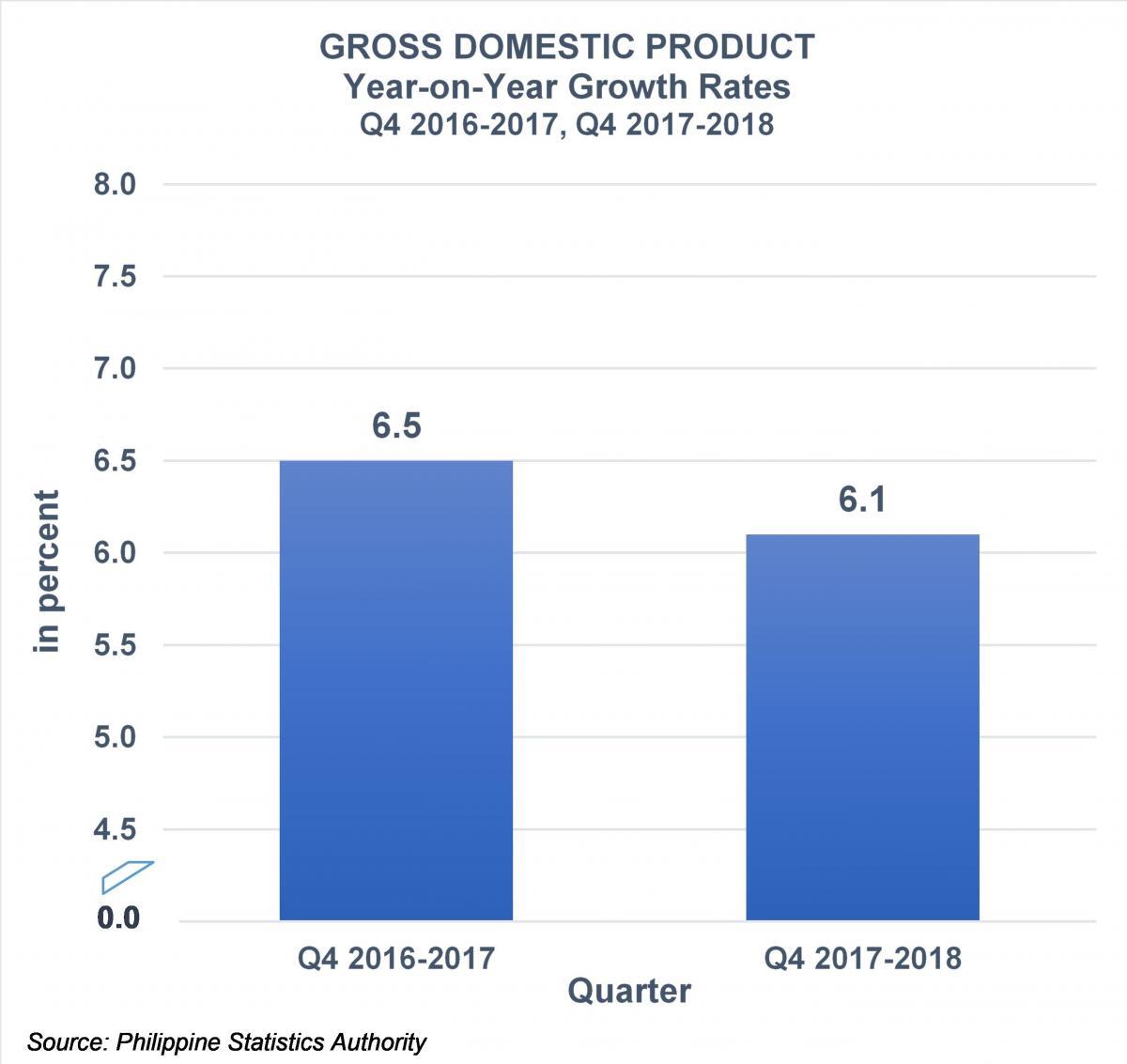PHL economic growth falls behind gov’t target in 2018

The Philippine economy grew by 6.1 percent in the fourth quarter of 2018, a growth rate that brought the full-year economic expansion to 6.2 percent.
Results of the gross domestic product (GDP) in October to December were below the government’s downward-revised target range of 6.5 to 6.9 percent last year.
The economy as measured by the GDP grew by 6.1 percent in the fourth quarter of 2018 growth, which compares with 6.5 percent a year earlier the 6.0 percent in the third quarter of 2018.
This brought the full-year growth to 6.2 percent in 2018, slower than the 6.7 percent registered the previous year.
“We are next to India, Vietnam, and China. From Q1 to Q3 of 2018, we overtook Indonesia and Thailand in terms of economic performance,” Economic Planning Secretary Ernesto Pernia said during the National Accounts briefing on Thursday.
.@PSAgovph : The Gross Domestic Product (GDP) grew by 6.1 percent in the fourth quarter of 2018, bringing the 2018 full-year growth to 6.2 percent.
— NEDA (@NEDAhq) January 24, 2019

Need a wellness break? Sign up for The Boost!
Stay up-to-date with the latest health and wellness reads.
Please enter a valid email address
Your email is safe with us
However, the 2018 GDP was the slowest in three years since the economy grew by 5.8 percent in 2015.
The National Economic and Development Authority and Philippine Statistics Authority (PSA) announced the GDP results in a press conference in Quezon City.
National Statistician Lisa Grace Bersales noted the fourth quarter growth was driven by construction; trade and repair of motor vehicles, motorcycles, personal and household goods; and other services.
Among the major economic sectors during the quarter, industry grew the fastest at 6.9 percent, followed by services at 6.3 percent, and agriculture at 1.7 percent.
In peso terms, the economy grew by 6.2 percent to P17.422 trillion last year from P15.806 trillion in 2017, according to the National Accounts data released by the PSA.
Pernia noted that the manufacturing sector was a laggard in the fourth quarter.
#PHGDP
— NEDA (@NEDAhq) January 24, 2019
.@SecPernia : Manufacturing, on the other hand, is an area of concern. For the last quarter of 2018, it only grew by 3.2 percent, a deceleration from 7.9 percent during the same period in 2017.
Faster-than-expected inflation during most of 2018 was the most debilitating factor that influenced economic growth, according to economists.
Adding to the downside was the weak performance of the agriculture sector, and then there was soaring inflation, Pernia said.
“I think there are several factors, of course, but I would highlight the performance of agriculture as a drop from 4 percent to 0.8 percent is a major failure,” he said.
Agriculture sector grew by 0.8 percent in 2018 from 4.0 percent the previous year, largely because of typhoons.
“I would say that also we had high inflation rates last year especially in the third quarter through the first two months of the fourth quarter,” Pernia said.
“Inflation hits the economy in two ways … It tempers spending—both household spending and government spending—and even investment spending because of high prices,” Pernia said.
“An inflation rate is a deflator. A high inflation rate always reduces your economic growth rate,” he added.
Moving forward, Pernia said the government must push for the passage of several reforms—the Public Services Act, the Foreign Investment Negative List, and the Rice Tariffication Act—to address policy uncertainties so that the 7.0 to 8.0 percent economic growth may be achieved.
“To remedy this, the government needs to first address the policy uncertainties, increase macro-competitiveness by enhancing the efficiency of transport, communications, and the overall logistics network,” he said.
“To ensure inclusivity, we need to focus on the integration of industries between small and medium enterprises on one hand, and large establishments on the other,” Pernia added. —KBK/VDS, GMA News

Need a wellness break? Sign up for The Boost!
Stay up-to-date with the latest health and wellness reads.
Please enter a valid email address
Your email is safe with us






